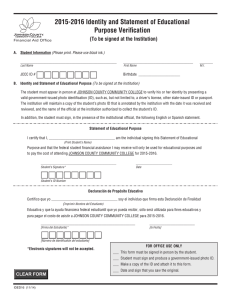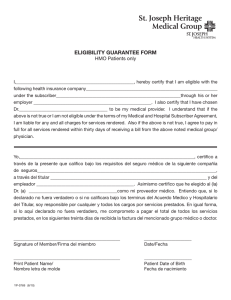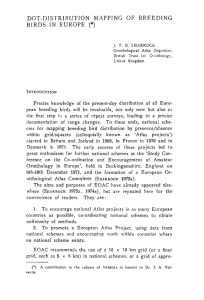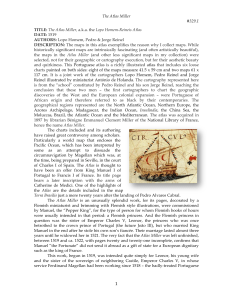Representantes Permanentes
Anuncio
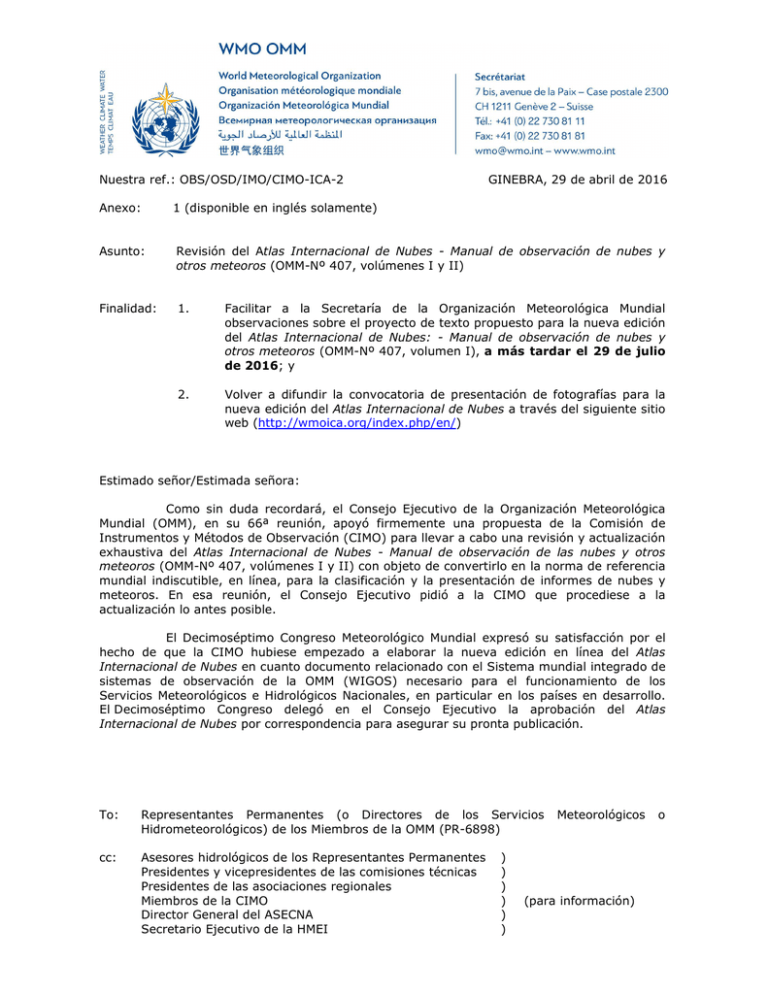
Nuestra ref.: OBS/OSD/IMO/CIMO-ICA-2 GINEBRA, 29 de abril de 2016 Anexo: 1 (disponible en inglés solamente) Asunto: Revisión del Atlas Internacional de Nubes - Manual de observación de nubes y otros meteoros (OMM-Nº 407, volúmenes I y II) Finalidad: 1. Facilitar a la Secretaría de la Organización Meteorológica Mundial observaciones sobre el proyecto de texto propuesto para la nueva edición del Atlas Internacional de Nubes: - Manual de observación de nubes y otros meteoros (OMM-Nº 407, volumen I), a más tardar el 29 de julio de 2016; y 2. Volver a difundir la convocatoria de presentación de fotografías para la nueva edición del Atlas Internacional de Nubes a través del siguiente sitio web (http://wmoica.org/index.php/en/) Estimado señor/Estimada señora: Como sin duda recordará, el Consejo Ejecutivo de la Organización Meteorológica Mundial (OMM), en su 66ª reunión, apoyó firmemente una propuesta de la Comisión de Instrumentos y Métodos de Observación (CIMO) para llevar a cabo una revisión y actualización exhaustiva del Atlas Internacional de Nubes - Manual de observación de las nubes y otros meteoros (OMM-Nº 407, volúmenes I y II) con objeto de convertirlo en la norma de referencia mundial indiscutible, en línea, para la clasificación y la presentación de informes de nubes y meteoros. En esa reunión, el Consejo Ejecutivo pidió a la CIMO que procediese a la actualización lo antes posible. El Decimoséptimo Congreso Meteorológico Mundial expresó su satisfacción por el hecho de que la CIMO hubiese empezado a elaborar la nueva edición en línea del Atlas Internacional de Nubes en cuanto documento relacionado con el Sistema mundial integrado de sistemas de observación de la OMM (WIGOS) necesario para el funcionamiento de los Servicios Meteorológicos e Hidrológicos Nacionales, en particular en los países en desarrollo. El Decimoséptimo Congreso delegó en el Consejo Ejecutivo la aprobación del Atlas Internacional de Nubes por correspondencia para asegurar su pronta publicación. To: Representantes Permanentes (o Directores de los Servicios Hidrometeorológicos) de los Miembros de la OMM (PR-6898) cc: Asesores hidrológicos de los Representantes Permanentes Presidentes y vicepresidentes de las comisiones técnicas Presidentes de las asociaciones regionales Miembros de la CIMO Director General del ASECNA Secretario Ejecutivo de la HMEI ) ) ) ) ) ) Meteorológicos (para información) o -2 Me complace informarle de que el Grupo de gesti6n de Ia CIMO ha aprobado el proyecto de texto actualizado de Ia nueva edoci6n del Atlas lntemacional de Nubes. En reconocimiento del caracter reglamentario de algunas partes del texto, entre las que se encuentra el anexo 1 al Reglamento Tecnico de Ia OMM, se sollcltara al Consejo Ejecutivo de Ia Organizaci6n, en su 68~ reuni6n, que su presidente apruebe el texto propuesto, slempre que no haya ninguna objecl6n de los Miem bros al proyecto de texto cuando concluya el periodo de revision obligato rio de tres meses (Regia 77). Por consiguiente, le ruego tenga a bien: 1. Examinar el proyecto de texto y t ransmit ir sus observaciones sobre el mismo al doctor W. Zhang, Director del Departamento de sistemas de observaci6n y de (wzhang@wmo. intl, con copia al doctor R. Atkinson informacion ([email protected]) con Ia mayor brevedad posible y, en todo caso, no mas tarde d el 29 de julio de 2016 . El proyecto de texto esta disponible unicamente en Ingles, en el sitio web de Ia OMM: httos://www.wmo.int/pages/proq/www!IMOPIIMOP-home.htm!. Hablda cuenta de su volumen y contenido tecnlco, tal vez desee convocar a los expertos pertinentes de su pais para que to ayuden a examonarto. Antes de iniciar el examen, seria util consultar Ia informacion expllcatova que se proporciona en el anexo de Ia presente carta ( tambien disponlble junto con el proyecto de texto en el sltlo web de Ia OMM). 2. Dar amplia difusi6n, dentro de su Servicio y entre otras lnstltuciones o asociaciones meteorol 6g lcas de su pa is, a esta convocatoria con objeto de que meteor61ogos profesionales, observadores meteoro!6gicos y fot6graros de nubes presenten sus propu estas de !mage nes para el nuevo Atlas Internaclonal de Nubes, como se solicit6 en Ia circular PR-6861 (r ef. 065-0SD-IMO-CIMO-ICA), de fecha 3 1 de julio de 2015. El sitlo web creado especialmente para este fin permanecera abierto en htto://wmoica.orgljndex.php/en/ hasta que se recopllen todas las imagenes requeridas. Aprovecho Ia ocasi6n para contrlbuco6n a Ia OMM y sus actividades. expresarte mi agradecimiento por su valiosa Le saluda atentamente. Al(Ul~~ (E. Manaenkova) por el Secreta rio General OBS/OSD/IMO/CIMO-ICA-2, ANNEX GUIDELINES FOR TEXT REVIEWERS OF THE 2016 DRAFT INTERNATIONAL CLOUD ATLAS The current edition of the International Cloud Atlas (ICA) - Manual on the Observation of Clouds and Other Meteors (WMO-No. 407) comprises two volumes. The first volume contains text and diagrams only, of which parts comprise Annex I to the WMO Technical Regulations. Volume II contains photographic images and captions only, to illustrate the many cloud types defined and described in Volume I. Volume II and its contents do not comprise WMO regulatory material, so are not subject to this review. The new edition of the ICA is to be web-based, so Volumes I and II will be integrated into one. The proposed draft text of the 2016 edition of the International Cloud Atlas is now ready for review by WMO Members. It can be downloaded from the WMO website at: https://www.wmo.int/pages/prog/www/IMOP/IMOP-home.html The draft text is contained in three separate files: • • • The first file includes all text from the Preface to the 1939 edition up to and including Chapter II.3; The second file includes Chapters II.4 up to and including II.8; The third and final file includes Chapter III plus the Appendices and proposed Glossary. A description is provided below of the main differences between the old edition of the text and the draft new edition. On completion of your review, please e-mail your feedback on the new version to Dr W. Zhang ([email protected] ), Director of the WMO Observations and Information Systems Department, with a copy to Dr R. Atkinson ([email protected]) under the title “Review of the 2016 Draft International Cloud Atlas”. Should you wish to include comments or suggestions on the draft text, you are requested to cut the relevant part of the text from the draft material, paste it into a new Word file, add your comments or suggestions to that and attach it to your e-mail. Thank you for reviewing the draft text of the new edition of the ICA. ANNEX, p. 2 Summary of Changes from the 1975 Edition of Volume I to the Current Draft Edition General The language used in the new draft has been modernized throughout: the use of obsolete or archaic words has been eliminated, with modern equivalents substituted, and the general style has been modernized. The order of sentences in the text has in some cases been changed to enhance logical flow. Because the new edition is to be primarily web-based, the text format has in many places been converted from simple text to tabular format. While changes to content are generally small, the appearance (layout and/or format) of existing tables has been modernized in many cases. Part I Apart from those general changes noted above, very few changes of substance have been proposed for Part I. Part II Chapter II.1.3.5 includes a description of the Special Clouds, each of which is now proposed for formal recognition in the classification scheme. The table of Chapter II.1.4 includes a number of new, formal classifications (1 new species, several new supplementary features and special clouds). These are described in more detail under Definitions of Clouds. In Chapter II.2.1.2, it has been proposed that, for the English version of the ICA, the use of the French term “étage” be discontinued and the English equivalent “level” be used, since in all other languages the same practice is followed. Chapter II.2.2 “Observational conditions to which definitions of clouds apply” has been moved to II.7.1, where it more appropriately belongs. Chapter II.2.3, Definitions of Clouds, becomes II.2.2. Much of the contents have been tabulated and there is more use of dot points, but apart from the inclusion of the new classifications (highlighted in yellow), little change has been made. Chapter II.3, Descriptions of Clouds, has many changes from the 1975 edition, but very few of substance. The first four subsections of each section contain regulatory text. Where small changes have been made to this regulatory text (modernization) all have been checked to ensure that interpretation will not change (to maintain traceability with time). Chapter II.4, Orographic Influences: The chapter contains no regulatory text. It has been extensively rewritten and the perspective has been changed. It now considers influences on the windward and leeward sides of orographic features, sequentially. Chapter II.5, Observations from Aircraft: This chapter contains no regulatory text. It has been rewritten to enhance clarity, but no significant changes have been made. Chapter II.6, Special Clouds: This chapter contains no regulatory text. It has been extensively rewritten and the title changed to ‘Upper Atmospheric Clouds’. Previously this chapter included all the special clouds, but now most have been formally classified and all that remains in this ANNEX, p. 3 category are the noctilucent and nacreous clouds. It has been rewritten to reflect the significant increases in knowledge that have occurred in this area since the 1975 edition. Chapter II.7, Observation of Clouds from the Earth’s Surface. This chapter contains no regulatory text. The introduction has been rearranged, uses dot points, and includes the material relocated from the previous Chapter II.2.2. A completely new feature of the new edition is the simple pictorial identification aid for the 10 Genera, which has been added in II.7.2. Chapter II.8, Coding of Clouds in the CL, CM and CH and Corresponding Symbols. II.8.2 and II.8.4 currently contain regulatory material. The technical and non-technical specifications for each cloud type in II.8.2 have been merged, and the commentary and further remarks for each cloud type have been included under an Explanation sub-heading for each. The detailed coding instructions for each cloud code have been moved to new sections of regulatory text: II.8.3.1-3. The three pictorial decision aids and guidance on their use (II.8.3.1-4) have been revised and improved in appearance and now appear together as non-regulatory text in II.8.3.4. Not all of the cloud symbols in II.8.4 have yet been sourced in visually appealing electronic format but will be added prior to publication, without change from the 1975 edition. Part III Chapter III.1 comprises regulatory material. The tables have been replaced and all subsections have been merged into one but only editorial changes have been made to the text to reach a wider audience. In Chapter III.2 all definitions in italics comprise regulatory material. The remainder of the text is non-regulatory. Significant expansion of explanatory text has been proposed throughout Part III where scientific knowledge has advanced greatly since 1975 and the section has been rewritten to simplify sentence structure and modernize the language. In Chapter III.2.1, Hydrometeors other than clouds, a new paragraph has been added on freezing fog, and there is new commentary on the various types of fog. New entries, including proposed definitions, appear for Snow Devil and Steam Devil. The title of Section III.2.1.5 Spout has been changed to Hydrometeors Consisting of a Vortex of Particles, and includes mention of the various types of spout and a table of tornado intensities. Chapter III.2.2 Lithometeors includes an enhanced section on dust/sand whirl/devil. Chapters III.2.3 Photometeors and III.2.4 Electrometeors have been extensively changed to include more descriptive explanations to reflect the large advances in understanding since 1975. In Chapter III.3 very little has been changed. Each of the three Appendices has been simply updated. A new Glossary has been added and the Index has been removed, to be replaced by an on-line search engine. __________


